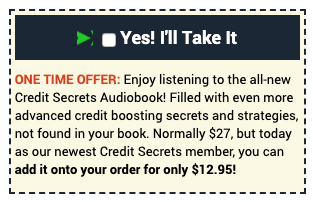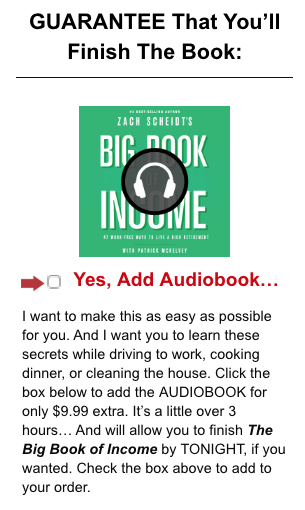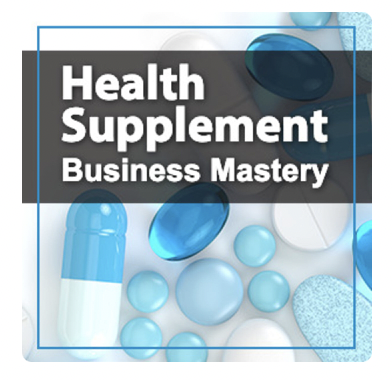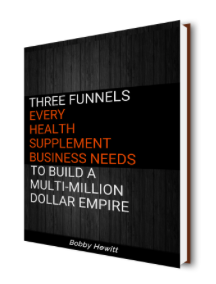Selling a dietary supplement off of a front-end book offer is a tried and true strategy for selling supplements online. Especially in places where dietary supplements are not seen as very favorable by advertisers.
The typical approach to selling a bottle of supplements off of a front-end book offer looks like this…
Book Offer > Up-sell 1 Supplement Offer
However the typical strategy of selling supplement bottles on the first up-sell may not be best way.
One of the core principles of maximizing sales on up-sells is to sell a congruent product.
Up-sells should always enhance the initial purchase in someway. The product you’re selling in the up-sell needs to be congruent with the previous one.
Think of each up-sell as an expansion on the overall problem your buyer has.
What will they need on their journey towards solving that problem?
If they just bought a book, that can be elevated to an audio version of that same book.
Or you could sell them a supplement bottle that solves the problem they are trying to eliminate from the book.
But which is better?
Let’s say a visitor just bought your free plus shipping book on how to reduce their high blood pressure. The natural supplement up-sell is to sell them a pill that does just that.
The book is the foundational information and may have a plan you can follow to reduce your blood pressure but it may take 30 – 90 days and require a lot of effort like changing your diet, exercising, etc.
The supplement offer is the fast track solution as compared to the book.
Selling speed is another core up-sell strategy that works.
The audio book is selling speed as well, because you can listen to the book faster than you could read it, if you read it at all.
Both offers, the audio book and the supplement bottle are the perfect fit for a one-time-only (OTO) up-sell offer, where the buyer is presented with an offer after the initial purchase.
But there’s another kind of up-sell we also need to look at…
Add-On Bump Offers
An add-on offer or bump offer as some call it, is like a mini up-sell. It appears on the order page with a simple check box to add it to your order.
It’s like an impulse buy.
Here’s a few examples…


Most marketers overlook offering an add-on offer. But they shouldn’t, it can add more to your average order value (AOV) and it makes a difference when every dollar counts in a cold traffic funnel.
An add-on is typically thought to add on a few dollars to cover the loss of the front-end, which is typically a free plus shipping book offer.
So an audio version would sell for something like $19.95 for physical CDs or a digital MP3 version. You could also have both options as two different add-on offers on the same order page.
So the typical book funnel with an add-on offer would look like this…
Book Offer > Audio Book Add-on > Up-sell 1 Supplement Offer
As you may know, your first up-sell is the most valuable spot for additional AOV.
Up-sell one is going to have the biggest take rate and you’re going to capture the lions share of your up-sell revenue from that spot.
But what if you flipped it on it’s head?
We were really curious what would happen if we bucked conventional wisdom.
So, we tested a funnel configuration that offered an audio book add-on against offering a supplement bottle.
Here’s the funnel configuration of the control…
Book Offer > Audio Book Add-on
Verses the funnel configuration of the treatment…
Book Offer > Supplement Offer Add-on
Essentially testing two different funnels. Each funnel received 1,200 front-end book sales. And the conversion rate for the book on both funnels was the same.
The difference is in the add-on.
In the control funnel: Book Offer > Audio Book Add-on
The audio book add-on converted at 4% a little low. I typically see 7% to 10% conversion rates on add-ons.
In the treatment funnel: Book Offer > Supplement Offer Add-on
The add-on supplement bottle converted at the same 4% but the ticket price was higher. $29.95 for a single bottle verses $19.95 for the audio book.
Most marketers think you can only sell low price points on add-ons, nothing more than a few bucks. And certainly not for more than the front-end ticket price, which in the case of a free plus shipping book is typically $4.95 – $9.95
This is absolutely not true. in both funnel configurations here the add-on price point is much much higher than the shipping cost on the front-end.
The important thing to note here is that the control add on of the audio book accounts for 9% of the total funnel revenue.
While the supplement bottle add on accounted for 19% of total funnel revenue.
It’s not just the conversion rate that’s important.
As you can see, the funnel makes more money by offering the supplement as an add-on offer.
Does this buck the idea of congruency?
No not at all…
Congruency is more than the same product or an easier way to consume the product.
It’s about solving the problem.
The supplement bottle works as an add-on because it solves faster than the problem the book is promising an answer for.
Speed and ease of use is still the strategy used here.
For example, if you’re selling a weight-loss front-end book, offer a detox up-sell as a way to jumpstart your way to better health or speed up your weight-loss.
Up-sells and add-ons should always be congruent with the previous buying decision, and problem your buyer is looking to solve.
If you look at the front-end from a buying decision perspective, what’s the best solution to the core problem is the next offer.
It’s often worth bucking the status quo way of thinking, especially when it comes to increasing revenue.
Discover the 3 funnels that can help your health supplement business succeed.

Listen to the Health Supplement Business Mastery Podcast for for dietary supplement entrepreneurs and marketers.



